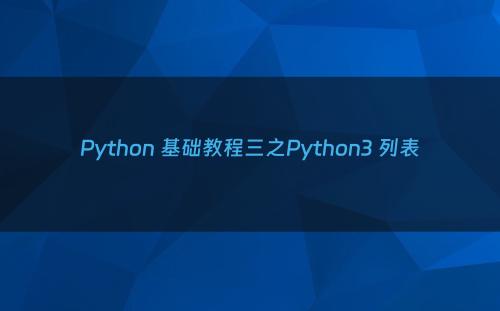前言
序列是 Python 中最基本的数据结构。
序列中的每个值都有对应的位置值,称之为索引,第一个索引是 0,第二个索引是 1,依此类推。
Python 有 6 个序列的内置类型,但最常见的是列表和元组。
列表都可以进行的操作包括索引,切片,加,乘,检查成员。
此外,Python 已经内置确定序列的长度以及确定最大和最小的元素的方法。
列表是最常用的 Python 数据类型,它可以作为一个方括号内的逗号分隔值出现。
列表的数据项不需要具有相同的类型
创建一个列表,只要把逗号分隔的不同的数据项使用方括号括起来即可。如下所示:
list1 = ['baidu','toutiao',1997,2000]
list2 = [1,2,3,4,5,6,7]
list3 = ["a","b","c","d"]
list4 = ['red','green','blue','yellow','white','black']访问列表中的值
与字符串的索引一样,列表索引从 0 开始,第二个索引是 1,依此类推。
通过索引列表可以进行截取、组合等操作。
#!/usr/bin/python3
list=['red','green','blue','yellow','white','black']
print(list[0])
print(list[1])
print(list[2])以上实例输出结果:
red
green
blue索引也可以从尾部开始,最后一个元素的索引为 -1,往前一位为 -2,以此类推。
#!/usr/bin/python3
list=['red','green','blue','yellow','white','black']
print(list[-1])
print(list[-2])
print(list[-3])以上实例输出结果:
black
white
yellow使用下标索引来访问列表中的值,同样你也可以使用方括号 [] 的形式截取字符,如下所示:
#!/usr/bin/python3
list = [10, 20, 30, 40, 50, 60, 70, 80, 90]
print(list[0:4])以上实例输出结果:
[10, 20, 30, 40]使用负数索引值截取:
#!/usr/bin/python3
list = ['Google', 'baidu', 'toutiao', 'Taobao', "zhihu"]
# 读取第二位
print("list[1]:",list[1])
# 从第二位开始(包含)截取到倒数第二位(不包含)
print("list[1:-2]:",list[1:-2])以上实例输出结果:
list[1]: baidu
list[1:-2]: ['baidu', 'toutiao']更新列表
你可以对列表的数据项进行修改或更新,你也可以使用 append() 方法来添加列表项,如下所示:
#!/usr/bin/python3
list = ['Google', 'baidu', 'toutiao', 'Taobao', "zhihu"]
print("第三个元素为:",list[2])
list[2] = 'tianmao'
print("更新后的第三个元素为:",list[2])
list.append('douyin')
print("更新后的列表:",list)注意:我们会在接下来的章节讨论 append() 方法的使用。
以上实例输出结果:
第三个元素为: toutiao
更新后的第三个元素为: tianmao
更新后的列表: ['Google', 'baidu', 'tianmao', 'Taobao', 'zhihu', 'douyin']删除列表元素
可以使用 del 语句来删除列表中的元素,如下实例:
#!/usr/bin/python3
list = ['Google', 'baidu', 'toutiao', 'Taobao', "zhihu"]
print("原始列表:",list)
del list[2]
print("删除第三个元素:",list)以上实例输出结果:
原始列表: ['Google', 'baidu', 'toutiao', 'Taobao', 'zhihu']
删除第三个元素: ['Google', 'baidu', 'Taobao', 'zhihu']注意:我们会在接下来的章节讨论 remove() 方法的使用
Python列表脚本操作符
列表对 + 和 * 的操作符与字符串相似。+ 号用于组合列表,* 号用于重复列表。
如下所示:
Python 表达式 | 结果 | 描述 |
len([1, 2, 3]) | 3 | 长度 |
[1, 2, 3] + [4, 5, 6] | [1, 2, 3, 4, 5, 6] | 组合 |
['Hi!'] * 4 | ['Hi!', 'Hi!', 'Hi!', 'Hi!'] | 重复 |
3 in [1, 2, 3] | True | 元素是否存在于列表中 |
for x in [1, 2, 3]: print(x, end=" ") | 1 2 3 | 迭代 |
Python 列表截取与拼接
Python 的列表截取与字符串操作类似,如下所示:
L=['Google', 'Runoob', 'Taobao']操作:
Python 表达式 | 结果 | 描述 |
L[2] | 'Taobao' | 读取第三个元素 |
L[-2] | 'Runoob' | 从右侧开始读取倒数第二个元素: count from the right |
L[1:] | ['Runoob', 'Taobao'] | 输出从第二个元素开始后的所有元素 |
>>> L=['Google', 'Runoob', 'Taobao']
>>> L[2]
'Taobao'
>>> L[-2]
'Runoob'
>>> L[1:]
['Runoob', 'Taobao']
>>>列表还支持拼接操作:
>>> squares = [1, 4, 9, 16, 25]
>>> squares += [36, 49, 64, 81, 100]
>>> squares
[1, 4, 9, 16, 25, 36, 49, 64, 81, 100]
>>>嵌套列表
使用嵌套列表即在列表里创建其它列表,例如:
>>> a = ['a', 'b', 'c']
>>> n = [1, 2, 3]
>>> x = [a, n]
>>> x
[['a', 'b', 'c'], [1, 2, 3]]
>>> x[0]
['a', 'b', 'c']
>>> x[0][1]
'b'列表比较
列表比较需要引入 operator 模块的 eq 方法(详见:Python operator 模块):
# 导入 operator 模块
import operator
a = [1, 2]
b = [2, 3]
c = [2, 3]
print("operator.eq(a,b): ", operator.eq(a,b))
print("operator.eq(c,b): ", operator.eq(c,b))以上代码输出结果为:
operator.eq(a,b): False
operator.eq(c,b): TruePython列表函数&方法
Python包含以下函数:
序号 | 函数 |
1 | len(list) |
2 | max(list) |
3 | min(list) |
4 | list(seq) |
Python包含以下方法:
序号 | 方法 |
1 | list.append(obj) |
2 | list.count(obj) |
3 | list.extend(seq) |
4 | list.index(obj) |
5 | list.insert(index, obj) |
6 | list.pop([index=-1]) |
7 | list.remove(obj) |
8 | list.reverse() |
9 | list.sort( key=None, reverse=False) |
10 | list.clear() |
11 | list.copy() |

